Camp Clothing Guide: From moisture-wicking tops to waterproof shoes, choose practical, weather-appropriate attire for a comfortable camping experience
When embarking on a camping adventure, your choice of clothing goes beyond just flaunting expensive gear or stylish ensembles. It's primarily about ensuring your well-being, shielding you from nature's unpredictable weather and conditions. The essence of camping attire lies in its practicality, helping you stay comfortable and safe as you immerse yourself in the great outdoors and face rain, wind, sun, and varying temperatures.
Here are some tips to help guide your clothing choices for your camping trip:

Weather and Climate Awareness
Before you set off, check the weather and climate conditions at your camping location. What you pack will vary whether you're camping in the mountains, on the beach, or in the forest.
For cold climates, bring warm clothing and consider layering. Don't forget hats and gloves.
For hot weather, pack lightweight clothes, hats, sunglasses, and ample sunscreen.
Choose Appropriate Footwear
Picking the right footwear is crucial when packing. The type of camping you're doing will dictate your choice.
For forest or hiking camping, sturdy hiking boots are essential.
Campgrounds with paved paths might call for sneakers or robust sandals.
Water activities may require water shoes or sandals.
Outfit for Various Activities
When considering what to wear while camping, make sure you bring clothes and gear that can be used for a variety of activities.
Versatile outfits can save space in your luggage and allow you to participate freely in different activities.
Attire like leggings or shorts, tank tops or T-shirts, and sport shoes or hiking sandals can be suitable for hiking, biking, walking, exploring, and lounging around the campsite.
Pack Clothes You Don't Mind Getting Dirty
Camping often involves getting down and dirty, especially if you're camping with kids. So, bring clothes you're comfortable with getting messy. Leave your designer items at home and opt for casual clothing that won't be ruined by campfire sparks or tears.
Camping Laundry
Camping laundry depends on the length of your trip. Some campsites offer self-service laundry facilities, but in primitive camping situations, you might need to get creative.
Use a small trash bin or bucket as an improvised washing machine. Fill it with water, detergent, and clothes, agitate with a stick or your hands, rinse, and hang to dry.
If there's a nearby stream or lake, you can wash clothes there, but avoid using soap as it can harm aquatic life.
Pack Layerable Clothing
Camping involves temperature fluctuations, even in summer. Pack layered clothing to adjust to these changes and stay comfortable.
Arrival Attire Matters
What you wear upon arrival is as important as what you bring along. Practicality is key.
Dress for the activities you have planned during your journey to the campsite. If there's hiking involved, opt for sturdy shoes and comfortable clothing.
Consider ease of setting up tents or gathering firewood when selecting your arrival outfit.
Day and Night Attire
Weather conditions and temperatures can vary significantly between day and night. Pack separate outfits to accommodate these changes.
Are Jeans Camping Appropriate?
The suitability of jeans for camping depends on your location and purpose. Jeans can be heavy and uncomfortable if you're backpacking or hiking.
They also take a long time to dry if they get wet.
Don't Forget Sunscreen and Insect Protection
Protecting yourself from the sun is essential when spending most (if not all) of your time outdoors. Bring sunscreen, hats, and sunglasses.
Additionally, insect repellent is crucial to keep annoying bugs at bay. Consider clothing with built-in insect repellent or wear long sleeves and pants to protect against bites.
Here are 9 clothing options for you to choose from:

- Moisture-Wicking Tops:
Stay cool and layer up with quick-drying shirts that wick away sweat. The lightweight, breathable fabric of moisture-wicking shirts is ideal for camping, allowing you to stay comfortable in various activities. Opt for short sleeves in warm months and layer up with long-sleeve shirts and jackets in colder seasons. Avoid cotton shirts that trap sweat and can leave you feeling sticky and uncomfortable. Choose shirts with sun protection for added skin safety, and for extra warmth during fall and winter camping, consider thermal options.
- Moisture-Wicking Pants or Shorts:
Combat the heat and cold with moisture-wicking pants or shorts. Camping can get sweaty, so these options are great for maintaining comfort while setting up tents or hiking. Steer clear of jeans as they retain sweat and can cause chafing. Consider cargo pants for added utility – pockets for snacks or rock collecting during hikes.
- Athletic Pants or Leggings:
Embrace freedom of movement with comfortable pants. Nylon athletic pants or moisture-wicking leggings are perfect for warm months, while wool-lined options are great for colder weather. These practical choices provide style and comfort for your camping adventures.
- Hoodies, Sweatshirts, or Vests:
Stay warm in unpredictable weather with an extra layer. Whether it's a wool hoodie, fleece sweatshirt, or insulated vest, having an additional layer is a must. Prepare for dropping nighttime temperatures during warmer camping trips, and pack wool-lined options for extra warmth during winter excursions.
- Rain Jacket or Parka:
Keep dry during rainy spells with waterproof outerwear. Pack a rain jacket, parka, or poncho to enjoy the outdoors even in wet conditions. These waterproof coverings can be easily layered over your existing clothing, ensuring you stay dry and cozy.
- Hiking Boots or Waterproof Sneakers:
Secure traction and dryness with proper footwear. Quality shoes with good grip and waterproof features are essential for various terrains. Opt for specialized hiking boots or trail sneakers designed for outdoor use. Thick-soled, well-arch-supported hiking boots are perfect for extra comfort and stability. For wet conditions or swimming, pack waterproof shoes to protect your feet from rocks.
- Baseball Cap or Beanie:
Shield your eyes from the sun and keep your head warm. Baseball caps or sun hats are ideal for warm camping months, while beanies provide warmth in colder conditions. Sunglasses can replace hats, and ear warmers can substitute for beanies if preferred.
- Gloves:
Maintain warm and dry hands with gloves. Wool gloves are perfect as a base layer for cold or snowy weather, and windproof gloves can be layered for extra warmth. Consider hand warmers and lotion to combat dryness and chilly weather.
- Breathable Underwear and Socks:
Stay dry and comfortable with lightweight undergarments. Breathable, quick-drying synthetic underwear and socks are crucial for keeping cool and avoiding discomfort. Invest in durable socks to prevent unwelcome holes during hikes. Choose the style that suits you best, ensuring they're breathable and moisture-wicking. Long wool socks are great for fall and winter camping, providing warmth for your feet and lower legs.
Conclusion
Your camping attire should strike a balance between comfort, functionality, and protection. By carefully considering the climate, activities, and terrain of your camping destination, you can ensure a comfortable and enjoyable outdoor experience. Remember, nature is your playground, so make sure your clothing choices support your adventure.

